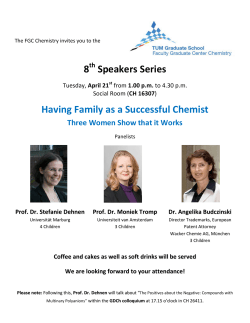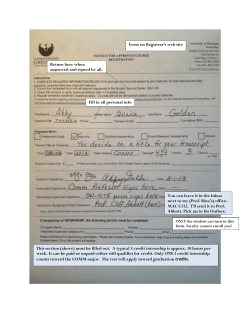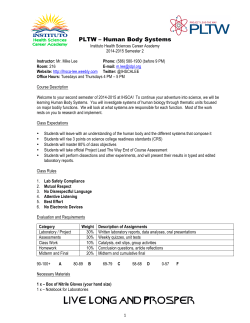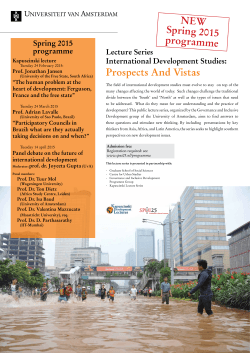
Electrochemistry Fundamentals 1. Energy Bands
Electrochemistry Fundamentals 1. Energy Bands Advanced Bio Convergence Micro/Nano SoC, Prof. JB Lee Energy bands An atom Energy Vacuum level A small molecule E=0 Empty states Filled states Bulk material A Large Molecule LUMO Fermi level HOMO LUMO: lowest unoccupied molecular orbital HOMO: highest occupied molecular orbital qChemistry is controlled by the electron transition around the filled/empty states. Advanced Bio Convergence Micro/Nano SoC, Prof. JB Lee Energy bands of various bulk materials Conduction band (CB) Small band gap between filled (VB) and empty states No band gap or overlapped between filled (VB) and empty (CB) states Large band gap between filled (VB) and empty (CB) states Valence band (VB) Core bands Metal Semiconductor Insulator qElectronic devices study is focused on semiconductors. qElectrochemistry study is focused on metals. Advanced Bio Convergence Micro/Nano SoC, Prof. JB Lee Energy bands of various bulk materials at 0 K Partially filled Completely filled Completely empty Ec Ec Eg Eg Ec Ev Ev Eg Ec Ev Ev Semiconductor Insulator Advanced Bio Convergence Micro/Nano SoC, Prof. JB Lee Metals Fermi level of semiconductors and metals q Fermi-Dirac distribution function 1 f (E ) = 1 + e ( E - EF ) kT Ei : Intrinsic semi.’s EF Intrinsic f(E): Probability that a state at energy E is occupied by an e- at temp. T 1 – f(E) : Probability that a state at energy E is empty at temp. T q Fermi level (EF) v An energy level which has a 50% probability of being occupied at any given time. n-type Φ: work function p-type Advanced Bio Convergence Micro/Nano SoC, Prof. JB Lee Fermi level of metals Advanced Bio Convergence Micro/Nano SoC, Prof. JB Lee What if you have two metals in contact? http://jas.eng.buffalo.edu/education/pn/pnformation_B/index.html Advanced Bio Convergence Micro/Nano SoC, Prof. JB Lee Ions in solution qElectrolyte vA substance that ionizes when dissolved in suitable ionizing solvents such as water. v Ex: salt in water Ø NaCl(s) → Na+(aq) + Cl−(aq) qIon’s electronic structure v HOMO, LUMO, HOMO-LUMO gap Advanced Bio Convergence Micro/Nano SoC, Prof. JB Lee Metal electrode in an electrolyte solution q Just like a pn junction, there are junction potentials whenever two dissimilar materials come into contact. q Charge is transferred to equilibrate Fermi levels, producing a charge separation and a contact potential difference. q This is the key interface for electrochemistry for bio sensing. Advanced Bio Convergence Micro/Nano SoC, Prof. JB Lee Chemical potential and electrochemical potential q Chemical potential (µ) v A potential energy that can be absorbed or released during a chemical reaction. q Fermi level (EF) v In semiconductor physics, the chemical potential of a system of electrons at a temperature of 0 K is known as the Fermi level. q Electrochemical potential (ECP, ̅ ) v v ECP represents how easy or difficult it is to add more of that species to that location. A species will move from areas with higher ECP to areas with lower ECP; in equilibrium, the ECP will be constant everywhere for each species. For example, if a glass of water has a lot of dissolved sugar on one side and none on the other side, each sugar molecule will randomly diffuse around the water, until there is equal concentration of sugar everywhere. We say that the sugar molecules have a "chemical potential," which is higher in the high-concentration areas, and the molecules move to lower their chemical potential. Advanced Bio Convergence Micro/Nano SoC, Prof. JB Lee Electrochemistry Fundamentals 2. Electrochemical Cells Advanced Bio Convergence Micro/Nano SoC, Prof. JB Lee Electrochemical cells qElectrochemistry is a study about energy interchange (by electron transfer between materials) between electrical domain and chemical domain. Chemical potential energy Galvanic cell (voltaic cell) Electrical potential energy Electrolytic cell qGalvanic cell (voltaic cell) vA spontaneous reaction generates electrical energy qElectrolytic cell v Absorbs energy from an electrical source to drive a nonspontaneous reaction Advanced Bio Convergence Micro/Nano SoC, Prof. JB Lee Redox reaction qRedox reaction v Oxidation: loss of 1 or more e- (becoming more +) v Reduction: gain of 1 or more e- (becoming more -) Ø Oil rig (oxidation involves loss, reduction involves gain) v Anode: oxidation occurs at the anode v Cathode: reduction occurs at the cathode © McGraw-Hill Advanced Bio Convergence Micro/Nano SoC, Prof. JB Lee Electrochemical half cell qHalf cell vA piece of metal (e.g., electrode) is placed in an electrolyte solution. Then, there is a charge separation across the boundary between the metal and the solution. Advanced Bio Convergence Micro/Nano SoC, Prof. JB Lee Half-cell potential Advanced Bio Convergence Micro/Nano SoC, Prof. JB Lee Half-cell potential Advanced Bio Convergence Micro/Nano SoC, Prof. JB Lee Reference electrode qStandard hydrogen electrode (SHE) v Hydrogen electrode is perfect as the reference electrode as it has E0 = 0 V. However, it is not practical due to the involvement of flowing hydrogen gas (potential for accidental explosion). q Ag/AgCl electrode + e- = Ag + Cl- (E0 = +0.22 V) v Inexpensive, not toxic v Most common v AgCl q Calomel electrode v Hg/HgCl v Toxic Advanced Bio Convergence Micro/Nano SoC, Prof. JB Lee Electrochemical cell qElectrochemical cell v Two half-cells are connected by a salt bridge or a filter paper membrane. Then, two electrodes are connected externally. v Salt bridge: Packed with a viscous, aqueous solution of NaCl, KCl or KNO3 in gel-ish agar. The viscosity prevents mixing with the electrolytes, but permitting exchange of charges. Advanced Bio Convergence Micro/Nano SoC, Prof. JB Lee Zn-Cu galvanic cell Potato/lemon battery: Cu wire on one side, galvanized nail (covered with Zn) on the other Advanced Bio Convergence Micro/Nano SoC, Prof. JB Lee Nernst equation qNernst equation RT E =E ln Q nF o n: number of moles F: Faraday’s constant (96485 C/mol.) R: universal gas constant (8.314 J/K-mol) T: absolute temperature Q: reaction quotient Advanced Bio Convergence Micro/Nano SoC, Prof. JB Lee Voltaic cell vs. electrolytic cell Advanced Bio Convergence Micro/Nano SoC, Prof. JB Lee
© Copyright 2025









